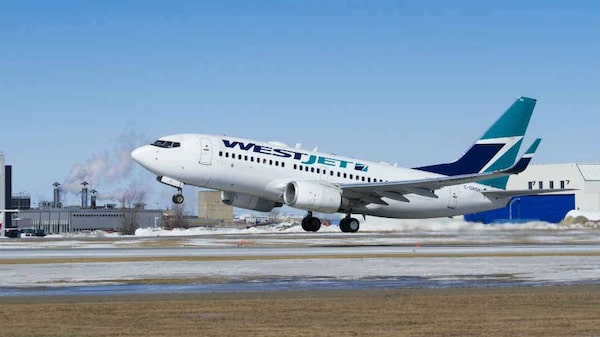
A WestJet plane is seen in this file photo.
WestJet Airlines Ltd. posted its first quarterly loss in 13 years in the three months ended June 30 amid the threat of a strike by pilots and soaring fuel costs.
The impact of the potential pilots strike will linger into the third quarter, WestJet officials said Tuesday because some people cancelled bookings they had scheduled for July. The strike threat was removed in late May after the airline and the pilots union agreed to go to binding arbitration if they can’t reach a deal.
Fuel prices are expected to be more damaging in the third quarter than they were in the second quarter – up between 35 per cent and 38 per cent in the current quarter versus a 31-per-cent surge in the second quarter from year-earlier levels.
The results sent WestJet shares tumbling. The stock closed down 8.2 per cent at $18.32 on the TSX Tuesday.
Amid the rising fuel prices and other cost pressures, WestJet will cut the number of available seat miles by 6 per cent and is examining routes to determine where capacity can be cut, executives said on a conference call Tuesday.
The airline is also assessing its “tolerance” to keep operating marginal routes that might turn a profit when fuel prices are low, but come under pressure when fuel costs are rising, chief executive officer Ed Sims said. “This environment forces you to be very focused on those tolerance levels.”
The threat of the strike wiped an estimated tens of millions of dollars in profit from the company’s books in the second quarter, chief financial officer Harry Taylor told analysts.
Travellers cancelled bookings and WestJet was forced into heavy discounting to try to win them back and attract new travellers, he said. But it has also put in place five fare increases since the beginning of the year to try to compensate for rising fuel prices.
The airline has not reported a loss since the first quarter of 2005, filings with securities regulators show.
In the most recent quarter, WestJet lost $20.8-million or 18 cents a share, compared with a profit of $41-million or 41 cents a year earlier. Revenue rose to $1.09-billion from $1.06-billion.
Revenue per available seat mile dropped 2 per cent while costs per available seat mile rose 9 per cent.
“We are of course disappointed with these results,” Mr. Sims said. “We’re not here for profitless volume.”
So management is focusing on reducing costs, including looking at ways to reduce the weight of its airplanes and what they carry, using auxiliary power units instead of engines while sitting on tarmacs and evaluating phasing in the delivery of new planes more slowly than originally planned.
In addition to the threatened strike by pilots, activity in the second quarter included the launch of Swoop, WestJet’s ultra low cost carrier (ULCC), as well as planning for the delivery of the airline’s first 787 wide-bodied aircraft and examining how they will be deployed internationally.
The ramp-up of Swoop means capacity will grow between 10 per cent and 11 per cent in the third quarter but will grow between 5.5 per cent and 6.5 per cent in all of 2018, compared with a previous forecast of growth of between 6.5 per cent and 8.5 per cent.
Revenue per available seat mile (RASM) is expected to drop between 4 per cent and 6 per cent in the third quarter because of the spillover effect of the strike threat during the second quarter, capacity increases by competitors in the Canadian market and a drop in partnership revenue from the loss of a code-sharing agreement with American Airlines.
The loss led National Bank of Canada airline analyst Cameron Doerksen to lower his rating on WestJet shares to “underperform” from “sector perform,” and cut his price target to $17 from $19.
“The company trimmed capacity growth plans and management believes the impact of strike-threat-driven fare discounting will dissipate by Q4 (driving potentially positive RASM in Q4), but we would like to see progress before becoming more positive on the stock,” Mr. Doerksen said in a research note.